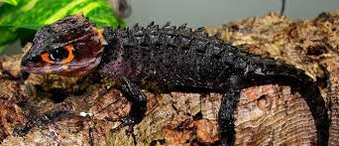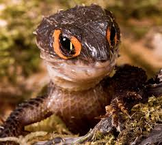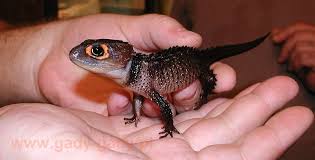Red-Eyed Crocodile Skink Care (Tribolonotus gracilis)
Erica Mede, CVT

Natural History
Also known as Tribbies, Orange-Eyed Crocodile skinks, or the Red-Eyed Busch Crocodile skink this lizard has become increasingly popular pet in the United States since 1994 when it debuted in the pet trade. Native to the tropical forests of New Guinea and Indonesia, this crepuscular lizard is commonly found scurrying across the ground and climbing branches, plants, and lattice work.
These 8-10 inch lizards are more of a visual pet rather than a one that can be handled often. Crocodile skinks will vocalize when in distress which is meant to alarm the captor (sometimes resulting in a startled drop reflex on the handler’s part) and may even play dead. Juveniles are more likely to play dead that the adults. This species of skink is also adept at “tail dropping” (autonomy) when startled. Their small stature, unique appearance, and relatively short life span of 8-10 years make skinks an ideal pet for many apartment residents. Juveniles are generally a dark brown with a white dorsal (back) stripe. Adults however are solid dark reddish brown with bright orange around the eyes giving them a striking appearance.
Enclosure
Red-Eyed Crocodile skinks are easily maintained in 10-gallon or 20-gallon glass aquarium or other enclosures of a similar size. Screen tops are a must for this species to ensure adequate ventilation. Two skinks can be kept in a 10-gallon enclosure so long as both skinks are female or one is male. Two males will fight and stress each other out. A 20-gallon tank can comfortably house 3-4 lizards. The larger the enclosure the better! Other options for enclosures include sweater box style containers that can be modified for ventilation, heating, and lighting. These reptiles are not truly arboreal. These skinks are predominantly terrestrial with an excellent climbing ability which should be taken into consideration during enclosure selection.
Cage Accessories
A naturalistic terrarium can be created for the using live potted plants such as Sansevierias, orchids, and bromeliads which stay relatively small. Fake plants can be used safely and give the same effect as natural plants but do not create humid environment. Potted plants should always be herbicide and insecticide free in case of accidental ingestion of the plant or soil by the reptile. Plants are not only visually pleasing to owners but offers enrichment and security for the skinks in the enclosure. It is ideal to supply as much shrubbery and foliage as possible.
Hides in the forms of rocks caves (not heat caves), small cork logs, and other creative locations should be placed in at least two locations in the enclosure. Preferably, one hide area should be provided on the warm end and one on the cooler end to promote thermoregulation with minimal stress on the animal.
Branches, bark, and some small rocks can be should be added to the enclosure for climbing and basking purposes. These skinks enjoy basking in the sun making it a necessity for there to be a branch closer to the basking light for normal behavior.
A water dish is invaluable to increasing the humidity in a Crocodile skink enclosure. Ideally, the water dish should be shallow enough for the lizard to walk in without submerging itself but deep enough that the water comes up to their shoulders for soaking. It is recommended to remove the water dish if live crickets are being fed as they tend to gravitate towards the water and drown. Most skinks will not eat deceased prey.
Also known as Tribbies, Orange-Eyed Crocodile skinks, or the Red-Eyed Busch Crocodile skink this lizard has become increasingly popular pet in the United States since 1994 when it debuted in the pet trade. Native to the tropical forests of New Guinea and Indonesia, this crepuscular lizard is commonly found scurrying across the ground and climbing branches, plants, and lattice work.
These 8-10 inch lizards are more of a visual pet rather than a one that can be handled often. Crocodile skinks will vocalize when in distress which is meant to alarm the captor (sometimes resulting in a startled drop reflex on the handler’s part) and may even play dead. Juveniles are more likely to play dead that the adults. This species of skink is also adept at “tail dropping” (autonomy) when startled. Their small stature, unique appearance, and relatively short life span of 8-10 years make skinks an ideal pet for many apartment residents. Juveniles are generally a dark brown with a white dorsal (back) stripe. Adults however are solid dark reddish brown with bright orange around the eyes giving them a striking appearance.
Enclosure
Red-Eyed Crocodile skinks are easily maintained in 10-gallon or 20-gallon glass aquarium or other enclosures of a similar size. Screen tops are a must for this species to ensure adequate ventilation. Two skinks can be kept in a 10-gallon enclosure so long as both skinks are female or one is male. Two males will fight and stress each other out. A 20-gallon tank can comfortably house 3-4 lizards. The larger the enclosure the better! Other options for enclosures include sweater box style containers that can be modified for ventilation, heating, and lighting. These reptiles are not truly arboreal. These skinks are predominantly terrestrial with an excellent climbing ability which should be taken into consideration during enclosure selection.
Cage Accessories
A naturalistic terrarium can be created for the using live potted plants such as Sansevierias, orchids, and bromeliads which stay relatively small. Fake plants can be used safely and give the same effect as natural plants but do not create humid environment. Potted plants should always be herbicide and insecticide free in case of accidental ingestion of the plant or soil by the reptile. Plants are not only visually pleasing to owners but offers enrichment and security for the skinks in the enclosure. It is ideal to supply as much shrubbery and foliage as possible.
Hides in the forms of rocks caves (not heat caves), small cork logs, and other creative locations should be placed in at least two locations in the enclosure. Preferably, one hide area should be provided on the warm end and one on the cooler end to promote thermoregulation with minimal stress on the animal.
Branches, bark, and some small rocks can be should be added to the enclosure for climbing and basking purposes. These skinks enjoy basking in the sun making it a necessity for there to be a branch closer to the basking light for normal behavior.
A water dish is invaluable to increasing the humidity in a Crocodile skink enclosure. Ideally, the water dish should be shallow enough for the lizard to walk in without submerging itself but deep enough that the water comes up to their shoulders for soaking. It is recommended to remove the water dish if live crickets are being fed as they tend to gravitate towards the water and drown. Most skinks will not eat deceased prey.

Temperature
Two thermometers should be utilized to ensure that the proper temperatures are being maintained. The cool end of the enclosure should have the thermometer an inch above the substrate. The thermometer on the warmer end of the enclosure should be at the level of the basking site.
Day time temperatures are typically maintained at 75-78°F Fahrenheit with a basking spot of 80-82°F. This is not a high heat species. The basking spot should be situated ideally with a rock over the under tank heater or heat cable and directly underneath the basking light. A branch high enough to rest under the basking spot is appropriate too as long as the reptile has no contact with the lamp itself. Care must be taken to prevent burns from basking lights by elevating the lamp itself off the cage screen.
If necessary, a fine wire mesh cage can be created around the lamp area to prevent accidental burns. When using under tank heaters or heat cable to increase the ambient temperature of the enclosure care must be that the animal never contacts the heating element itself or the glass/wire/plastic directly over it. A layer of substrate must be provided over the enclosure floor to prevent burns.
At night, the temperatures can drop as low as 68°F degrees Fahrenheit but are best maintained between 70°F and 72°F degrees. If the ambient temperature in the room the reptile is in drops below 68°F it is recommended to utilize the under tank heaters, heat cable, or a ceramic heat emitter (does not give off visible light).
Humidity
The humidity in the skink’s enclosure should be kept at 70-90%. A water dish is an excellent way to keep the humidity up especially when it is placed over an under tank heater. Misting 2-3 times a day can keep the humidity up but saran wrap may be needed to cover half the screen lid (if used) to maintain the humidity. Like wise, a full screen enclosure may require saran wrap on one or two sides to prevent excessive drying of the enclosure. A drip system or misting system is excellent for maintaining humidity and allow the skink to drink droplets. Some may learn to use a water dish but offering water droplets on leaves is a great choice.
Two thermometers should be utilized to ensure that the proper temperatures are being maintained. The cool end of the enclosure should have the thermometer an inch above the substrate. The thermometer on the warmer end of the enclosure should be at the level of the basking site.
Day time temperatures are typically maintained at 75-78°F Fahrenheit with a basking spot of 80-82°F. This is not a high heat species. The basking spot should be situated ideally with a rock over the under tank heater or heat cable and directly underneath the basking light. A branch high enough to rest under the basking spot is appropriate too as long as the reptile has no contact with the lamp itself. Care must be taken to prevent burns from basking lights by elevating the lamp itself off the cage screen.
If necessary, a fine wire mesh cage can be created around the lamp area to prevent accidental burns. When using under tank heaters or heat cable to increase the ambient temperature of the enclosure care must be that the animal never contacts the heating element itself or the glass/wire/plastic directly over it. A layer of substrate must be provided over the enclosure floor to prevent burns.
At night, the temperatures can drop as low as 68°F degrees Fahrenheit but are best maintained between 70°F and 72°F degrees. If the ambient temperature in the room the reptile is in drops below 68°F it is recommended to utilize the under tank heaters, heat cable, or a ceramic heat emitter (does not give off visible light).
Humidity
The humidity in the skink’s enclosure should be kept at 70-90%. A water dish is an excellent way to keep the humidity up especially when it is placed over an under tank heater. Misting 2-3 times a day can keep the humidity up but saran wrap may be needed to cover half the screen lid (if used) to maintain the humidity. Like wise, a full screen enclosure may require saran wrap on one or two sides to prevent excessive drying of the enclosure. A drip system or misting system is excellent for maintaining humidity and allow the skink to drink droplets. Some may learn to use a water dish but offering water droplets on leaves is a great choice.

Lighting
All reptiles benefit from some level of UVB lighting. The best is natural sunlight but most captive reptiles rely on specialized UVB emitting bulbs. Crocodile skinks benefit from a 5.0 UVB bulb that can be found at most local pet stores selling reptile supplies. The UVB light should be on 12 hours a day during the day light portion of the light cycle.
Substrate
Crocodile skinks are primarily terrestrial but they do not burrow or dig. An excellent substrate to use for an enclosure would be indoor/outdoor or reptile carpet which is more visually pleasing than newspaper and easier to clean than paper towel. All are excellent choices are although for a hygienic cage set-up. Plants can be potted in top soil only to avoid accidental ingestion of toxic materials. Naturalistic vivariums can be created but are beyond the scope of this care sheet.
Feeding
The Crocodile skink is a true insectivore, relishing small roaches (such as Dubias), small silk worms, small meal worms, small crickets, and small red worms (“red wrigglers”). A rule of thumb for feeding crocodile skinks is the food item offered should always be live and only half the size of the skink's head. Hatchling and young lizards should be offered 2-3 food items once a day and adults should be offered 2-3 food items every other day. Feeder insects should be appropriately gut loaded by offering them dark leafy greens such as kale or endive and carrots (for added vitamin A) 24-48 hours before feeding to the skink. This method of gut loading helps keep the prey items alive longer. Always remove uneaten food after an hour.
If you have any questions, please feel free to call us at 847-329-8709.
All reptiles benefit from some level of UVB lighting. The best is natural sunlight but most captive reptiles rely on specialized UVB emitting bulbs. Crocodile skinks benefit from a 5.0 UVB bulb that can be found at most local pet stores selling reptile supplies. The UVB light should be on 12 hours a day during the day light portion of the light cycle.
Substrate
Crocodile skinks are primarily terrestrial but they do not burrow or dig. An excellent substrate to use for an enclosure would be indoor/outdoor or reptile carpet which is more visually pleasing than newspaper and easier to clean than paper towel. All are excellent choices are although for a hygienic cage set-up. Plants can be potted in top soil only to avoid accidental ingestion of toxic materials. Naturalistic vivariums can be created but are beyond the scope of this care sheet.
Feeding
The Crocodile skink is a true insectivore, relishing small roaches (such as Dubias), small silk worms, small meal worms, small crickets, and small red worms (“red wrigglers”). A rule of thumb for feeding crocodile skinks is the food item offered should always be live and only half the size of the skink's head. Hatchling and young lizards should be offered 2-3 food items once a day and adults should be offered 2-3 food items every other day. Feeder insects should be appropriately gut loaded by offering them dark leafy greens such as kale or endive and carrots (for added vitamin A) 24-48 hours before feeding to the skink. This method of gut loading helps keep the prey items alive longer. Always remove uneaten food after an hour.
If you have any questions, please feel free to call us at 847-329-8709.
